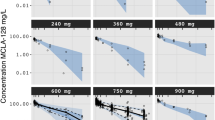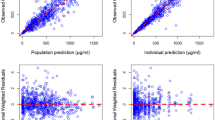Abstract
Introduction
Bintrafusp alfa, an innovative first-in-class bifunctional fusion protein composed of the extracellular domain of the TGF-βRII receptor (a TGF-β “trap”) fused to a human IgG1 monoclonal antibody blocking programmed death ligand 1, has shown promising antitumor activity and manageable safety.
Methods
To support the dosing strategy for bintrafusp alfa, we developed a population pharmacokinetics model using a full covariate modeling approach, based on pharmacokinetic and covariate data from 644 patients with various solid tumors who received bintrafusp alfa intravenously in two clinical studies.
Results
A two-compartmental linear model best described bintrafusp alfa concentrations, and no time-varying clearance was identified. Using this model, the estimated clearance was 0.0158 l/h (relative standard error, 4.1%), and the central and peripheral volume of distribution were 3.21 l (relative standard error, 3.2%) and 0.483 l (relative standard error, 9.8%), respectively. The estimated mean elimination half-life of bintrafusp alfa was 6.93 days (95% CI 4.69–9.65 days). Several intrinsic factors (bodyweight, albumin, sex, and tumor type) were found to influence bintrafusp alfa pharmacokinetics, but none of these covariate effects was considered clinically meaningful and no dosage adjustments are recommended. Notably, simulations from the model suggested less variability in exposure metrics with flat dosing versus weight-based dosing.
Conclusions
Pharmacokinetic analysis of bintrafusp alfa supports the use of a flat dose regimen in further clinical trials (recommended phase 2 dose: 1200 mg every 2 weeks).
Trial registration
ClinicalTrials.gov identifiers: NCT02517398 and NCT02699515.
Funding
Merck Healthcare KGaA as part of an alliance between Merck Healthcare KGaA and GlaxoSmithKline.





Similar content being viewed by others
References
Akhurst RJ, Hata A. Targeting the TGFbeta signalling pathway in disease. Nat Rev Drug Discov. 2012;11:790–811.
Yang L, Pang Y, Moses HL. TGF-beta and immune cells: an important regulatory axis in the tumor microenvironment and progression. Trends Immunol. 2010;31:220–7.
Principe DR, Doll JA, Bauer J, et al. TGF-β: duality of function between tumor prevention and carcinogenesis. J Natl Cancer Inst. 2014;106:djt369.
Ferris RL, Lenz H-J, Trotta AM, et al. Rationale for combination of therapeutic antibodies targeting tumor cells and immune checkpoint receptors: harnessing innate and adaptive immunity through IgG1 isotype immune effector stimulation. Cancer Treat Rev. 2018;63:48–60.
Lan Y, Zhang D, Xu C, et al. Enhanced preclinical antitumor activity of M7824, a bifunctional fusion protein simultaneously targeting PD-L1 and TGF-beta. Sci Transl Med. 2018;10(424).
David JM, Dominguez C, McCampbell KK, Gulley JL, Schlom J, Palena C. A novel bifunctional anti-PD-L1/TGF-β trap fusion protein (M7824) efficiently reverts mesenchymalization of human lung cancer cells. Oncoimmunology. 2017;6:e1349589.
Strauss J, Heery CR, Schlom J, et al. Phase I trial of M7824 (MSB0011359C), a bifunctional fusion protein targeting PD-L1 and TGFβ, in advanced solid tumors. Clin Cancer Res. 2018;24:1287–95.
Fujiwara Y, Koyama T, Helwig C, Watanabe M, Doi T. M7824 (MSB0011359C), a bifunctional fusion protein targeting PD-L1 and TGF-β, in Asian patients with advanced solid tumors. J Clin Oncol. 2018;36 (abstract 762).
Paz-Ares LG, Kim TM, Vicente Baz D, et al. Results from a second-line (2L) NSCLC cohort treated with M7824 (MSB0011359C), a bifunctional fusion protein targeting TGF-β and PD-L1. J Clin Oncol. 2018;36 (abstract 9017).
Tan B, Khattak A, Felip E, et al. M7824 (MSB0011359C), a bifunctional fusion protein targeting PD-L1 and TGF-β, in patients with post-platinum esophageal adenocarcinoma (EAC): preliminary results from a phase 1 cohort. Ann Oncol. 2018;29 (abstract 643P).
Cho B, Daste A, Ravaud A, et al. M7824 (MSB0011359C), a bifunctional fusion protein targeting PD-L1 and TGF-β, in patients (pts) with advanced SCCHN: results from a phase 1 cohort. Ann Oncol. 2018;29 (abstract 1048O).
Kopetz S, Spira AI, Wertheim M, et al. M7824 (MSB0011359C), a bifunctional fusion protein targeting PD-L1 and TGF-β, in patients with heavily pretreated CRC: preliminary results from a phase I trial. J Clin Oncol. 2018;36 (abstract 764).
Bang Y-J, Doi T, Kondo S, et al. Updated results from a phase 1 trial of M7824 (MSB0011359C), a bifunctional fusion protein targeting PD-L1 and TGF-β, in patients with pretreated recurrent or refractory gastric cancer. Ann Oncol. 2018;29 (abstract 661P).
Lin C-C, Doi T, Muro K, et al. Phase 1 study results from an esophageal squamous cell carcinoma (ESCC) cohort treated with M7824 (MSB0011359C), a bifunctional fusion protein targeting transforming growth factor β (TGF-β) and PD-L1. Ann Oncol. 2018;29 (abstract 642P).
Barlesi F, Isambert N, Enriqueta F, et al. Initial results from phase 1 trial of M7824 (MSB0011359C), a bifunctional fusion protein targeting PD-L1 and TGF-β, in patients with NSCLC refractory or resistant to prior anti–PD-1/anti–PD-L1 agents. J Immunother Cancer. 2017;5:86 (abstract O14).
Strauss J, Gatti-Mays ME, Redman J, et al. Safety and activity of M7824, a bifunctional fusion protein targeting PD-L1 and TGF-β, in patients with HPV associated cancers. J Clin Oncol. 2018;36 (abstract 3007).
Kang Y-K, Doi T, Kondo S, et al. M7824 (MSB0011359C), a bifunctional fusion protein targeting PD-L1 and TGF-β, in Asian patients with pretreated recurrent or refractory gastric cancer: preliminary results from a phase I trial. J Clin Oncol. 2018;36 (abstract 100).
Yoo C, Oh D-Y, Choi H, et al. M7824 (MSB0011359C), a bifunctional fusion protein targeting PD-L1 and TGF-β, in Asian patients with pretreated biliary tract cancer: preliminary results from a phase 1 trial. Ann Oncol. 2018;29 (abstract 757P).
Vugmeyster Y, Wilkins J, Harrison-Moench E, et al. Selection of the recommended phase 2 dose (RP2D) for M7824 (MSB0011359C), a bifunctional fusion protein targeting TGF-β and PD-L1. J Clin Oncol. 2018;36 (abstract 2566).
Wang DD, Zhang S, Zhao H, Men AY, Parivar K. Fixed dosing versus body size-based dosing of monoclonal antibodies in adult clinical trials. J Clin Pharmacol. 2009;49:1012–24.
Liu C, Yu J, Li H, et al. Association of time-varying clearance of nivolumab with disease dynamics and its implications on exposure response analysis. Clin Pharmacol Ther. 2017;101:657–66.
Li H, Yu J, Liu C, et al. Time dependent pharmacokinetics of pembrolizumab in patients with solid tumor and its correlation with best overall response. J Pharmacokinet Pharmacodyn. 2017;44:403–14.
Baverel PG, Dubois VFS, Jin CY, et al. Population pharmacokinetics of durvalumab in cancer patients and association with longitudinal biomarkers of disease status. Clin Pharmacol Ther. 2018;103:631–42.
Wilkins J, Brockhaus B, Wang S, et al. Population pharmacokinetic analysis of avelumab in different cancer types. J Pharmacokinet Pharmacodyn. 2017;44:11–143.
Beal SL, Sheiner LB, Boeckmann AJ, Bauer RJ. NONMEM users guides. Ellicott City: Icon Development Solutions; 1989.
R Development Core Team. R: a language and environment for statistical computing. Vol. 3.3.1. Vienna, Austria: R Foundation for Statistical Computing; 2013. https://www.R-project.org/.
Keizer RJ, Karlsson MO, Hooker A. Modeling and simulation workbench for NONMEM: tutorial on Pirana, PsN, and Xpose. CPT Pharm Syst Pharmacol. 2013;2:e50.
Lindbom L, Ribbing J, Jonsson EN. Perl-speaks-NONMEM (PsN)–a Perl module for NONMEM related programming. Comput Methods Programs Biomed. 2004;75:85–94.
Keizer RJ, van Benten M, Beijnen JH, Schellens JHM, Huitema ADR. Piraña and PCluster: a modeling environment and cluster infrastructure for NONMEM. Comput Methods Programs Biomed. 2011;101:72–9.
Bergstrand M, Hooker AC, Wallin JE, Karlsson MO. Prediction-corrected visual predictive checks for diagnosing nonlinear mixed-effects models. AAPS J. 2011;13:143–51.
Karlsson MO, Sheiner LB. The importance of modeling interoccasion variability in population pharmacokinetic analyses. J Pharmacokinet Biopharm. 1993;21:735–50.
Gastonguay MR. Full covariate models as an alternative to methods relying on statistical significance for inferences about covariate effects: a review of methodology and 42 case studies. In: Presented at the PAGE Annual Meeting; June 7–10, 2011; Athens, Greece (abstract 2229).
Wählby U, Thomson AH, Milligan PA, Karlsson MO. Models for time-varying covariates in population pharmacokinetic-pharmacodynamic analysis. Br J Clin Pharmacol. 2004;58:367–77.
Ryman JT, Meibohm B. Pharmacokinetics of monoclonal antibodies. CPT Pharm Syst Pharmacol. 2017;6:576–88.
Zhao X, Suryawanshi S, Hruska M, et al. Assessment of nivolumab benefit-risk profile of a 240-mg flat dose relative to a 3-mg/kg dosing regimen in patients with advanced tumors. Ann Oncol. 2017;28:2002–8.
Freshwater T, Kondic A, Ahamadi M, et al. Evaluation of dosing strategy for pembrolizumab for oncology indications. J Immunother Cancer. 2017;5:43.
Stroh M, Winter H, Marchand M, et al. Clinical pharmacokinetics and pharmacodynamics of atezolizumab in metastatic urothelial carcinoma. Clin Pharmacol Ther. 2017;102:305–12.
Acknowledgements
The authors would like to acknowledge Nadia Terranova for her contribution in setting up the initial version of the dataset and model. The authors also thank the patients and their families, investigators and co-investigators, and study teams at each of the participating sites and at Merck Healthcare KGaA and at its subsidiary EMD Serono.
Funding
This study and the Rapid Service Fees were sponsored by Merck Healthcare KGaA as part of an alliance between Merck Healthcare KGaA and GlaxoSmithKline. All authors had full access to all of the data in this study and take complete responsibility for the integrity of the data and accuracy of the data analysis.
Medical Writing and Editorial Assistance
Medical writing assistance was provided by Amy Davidson, PhD, of ClinicalThinking, which was funded by Merck Healthcare KGaA and GlaxoSmithKline in accordance with Good Publication Practice (GPP3) guidelines (http://www.ismpp.org/gpp3).
Authorship
All named authors meet the International Committee of Medical Journal Editors (ICMJE) criteria for authorship for this article, take responsibility for the integrity of the work as a whole, and have given their approval for this version to be published.
Authorship Contributions
Justin J. Wilkins performed the analysis and Akash Khandelwal assisted with aspects of the analysis. Yulia Vugmeyster, Isabelle Dussault, Pascal Girard, and Akash Khandelwal provided significant intellectual input into the analysis and the manuscript.
Disclosures
Justin J. Wilkins was employed as a consultant by Merck Healthcare KGaA at the time the analysis was performed. Yulia Vugmeyster is an employee of EMD Serono, a business of Merck Healthcare KGaA. Isabelle Dussault is an employee of EMD Serono. Pascal Girard is an employee of Merck Serono S.A., Lausanne, Switzerland, an affiliate of Merck Healthcare KGaA. Akash Khandelwal is an employee of Merck Healthcare KGaA.
Compliance with Ethics Guidelines
Both clinical trials included in this study were conducted following international standards of good clinical practice consistent with the International Conference on Harmonisation Topic E6 Good Clinical Practice and the Declaration of Helsinki and its later amendments. Patients were enrolled in accordance with a protocol approved by the principal and coordinating investigator of the trial and relevant regulatory authorities at all participating centers. Informed consent was obtained from all individual participants included in the study.
Data Availability
For all new products or new indications approved in both the European Union and the United States after January 1, 2014, Merck Healthcare KGaA will share patient-level and study-level data after de-identification, as well as redacted study protocols and clinical study reports from clinical trials in patients. These data will be shared with qualified scientific and medical researchers, upon researcher’s request, as necessary for conducting legitimate research. Such requests must be submitted in writing to the company’s data sharing portal. More information can be found at https://www.merckgroup.com/en/research/our-approach-to-research-and-development/healthcare/clinical-trials/commitment-responsible-data-sharing.html. Where Merck Healthcare KGaA has a co-research, co-development or co-marketing/co-promotion agreement or where the product has been out-licensed, it is recognized that the responsibility for disclosure may be dependent on the agreement between parties. Under these circumstances, Merck Healthcare KGaA will endeavor to gain agreement to share data in response to requests.
Author information
Authors and Affiliations
Corresponding author
Additional information
Enhanced Digital Features
To view enhanced digital features for this article go to https://doi.org/10.6084/m9.figshare.8218181.
Electronic supplementary material
Below is the link to the electronic supplementary material.
Rights and permissions
About this article
Cite this article
Wilkins, J.J., Vugmeyster, Y., Dussault, I. et al. Population Pharmacokinetic Analysis of Bintrafusp Alfa in Different Cancer Types. Adv Ther 36, 2414–2433 (2019). https://doi.org/10.1007/s12325-019-01018-0
Received:
Published:
Issue Date:
DOI: https://doi.org/10.1007/s12325-019-01018-0




